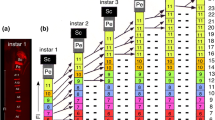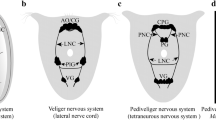Summary
The Merkel cells in the larval tentacles of Xenopus laevis were examined by TEM. Different forms of Merkel cells were found, depending on the age of the larvae or the location in the tentacles. These forms have the appearance of intermediate states between Merkel cells and superficial epidermal cells; thus an epidermal origin for the Merkel cells seems more likely than an immigration from the neural crest. The forms differ in (1) their location in the epidermis, (2) their shape, (3) the number and extension of their desmosomes, (4) the content and distribution of dense-core granules, and (5) the outgrowth of their finger-like processes. Also the relation to a nerve ending is different. By marking Merkel cells with quinacrine, fluorescence spots were observed between the superficial and basal epidermal cells or, in the very tip, within the superficial epidermal cells. These latter spots represent immature Merkel cells, as confirmed by TEM. This indicates a development of Merkel cells from superficial epidermal cells and migration towards the basal layer. Dermal Merkel cells were nerver observed.
Similar content being viewed by others
References
Breathnach AS (1977) Electron microscopy of cutaneous nerves and receptors. J Invest Dermatol 69:8–26
Breathnach AS (1980) The mammalian and avian Merkel cell. In: Spearman RIC, Riley PA (eds) The skin of vertebrates. Academic Press London, Linnean Society Symposium Series no. 9, pp 283–291
Breathnach AS, Robins E (1970) Ultrastructural observations on Merkel cells in human foetal skin. J Anat 106:411
Brown AL (1970) The African clawed toad Xenopus laevis. Butterworths, London
Crowe R, Whitear M (1978) Quinacrine fluorescence of Merkel cells in Xenopus laevis. Cell Tissue Res 190:273–283
English KB (1974) Cell types in cutaneous type I mechanoreceptors (Haarscheiben) and their alterations with injury. Am J Anat 141:105–126
English KB, Burgess PR, Kavka-van Norman D (1980) Development of rat Merkel cells. J Comp Neurol 194:475–496
Fortman GJ, Winkelmann RK (1973) A Merkel cell nuclear inclusion. J Invest Dermatol 61:334–338
Garant PR, Feldman J, Cho MI, Cullen MR (1980) Ultrastructure of Merkel cells in the hard palate of the squirrel monkey (Saimiri sciureus). Am J Anat 157:155–167
Gottschaldt KM, Vahle-Hinz C (1981) Merkel cell receptors: structure and transducer function. Science 214:183–186
Gottschaldt KM, Vahle-Hinz C (1982) Evidence against transmitter function of Met-enkephalin and chemosynaptic impulse generation in “Merkel cell” mechanoreceptors. Exp Brain Res 45:459–463
Gould VE, Moll R, Moll I, Lee I, Franke WW (1985) Biology of disease. Neuroendocrine (Merkel) cells of the skin: hyperplasias, dysplasias, and neoplasms. Lab Invest 52:334–353
Halata Z (1979) Spezifische Innervation. In: Orfanos CE (ed) Haar und Haarkrankheiten, Gustav Fischer Verlag, Stuttgart, New York, pp 123–136
Halata Z (1981) Postnatale Entwicklung sensibler Nervenendigungen in der unbehaarten Nasenhaut der Katze. Bibl Anat 19:210–235
Halata Z, Munger BL (1986) The neuroanatomical basis for the protopathic sensibility of the human glans penis. Brain Res 371:205–230
Hartschuh W, Weihe E, Büchler M, Helmstaedter V, Feurle GE, Forssmann WG (1979) Met-enkephalin-like immunoreactivity in Merkel cells. Cell Tissue Res 201:343–348
Hartschuh W, Weihe E, Büchler M (1980) Met-enkephalin-like immunoreactivity in Merkel cells of various species. J Invest Dermatol 74:453
Hartschuh W, Weihe E, Yanaihara N, Reinecke M (1983) Immunohistochemical localization of vasoactive intestinal polypeptide (VIP) in Merkel cells of various mammals: Evidence for a neuromodulator function of the Merkel cell. J Invest Dermatol 81:361–364
Hartschuh W, Reinecke M, Weihe E, Yanaihara N (1984) VIP-immunoreactivity in the skin of various mammals: Immunohistochemical, radioimmunological and experimental evidence for a dual localization in cutaneous nerves and Merkel cells. Peptides 5:239–245
Hartschuh W, Weihe E, Reinecke M (1986) The Merkel cell. In: Bereiter-Hahn J, Matoltsy AG, Richards KS (eds) Biology of the integument, Vol 2 Vertebrates, Springer Verlag, Berlin, Heidelberg, New York, Tokyo, pp 605–620
Hashimoto K (1972) The ultrastructure of human embryos. X. Merkel tactile cells in the finger and nail. J Anat 111:99–120
Iggo A, Andres KH (1982) Morphology of cutaneous receptors. Ann Rev Neurosci 5:1–31
Iggo A, Muir AR (1969) The structure and transducer function of a slowly adapting touch corpuscle in hairy skin. J Physiol (Lond) 200:763–796
Klauer G (1986) Die Mechanoreceptoren in der Haut der Wirbeltiere: Morphologie und Klassifizierung. Z Mikrosk Anat Forsch Leipzig 100:273–289
Milloning G (1961) Advantage of a phosphate buffer for Osmium solutions in fixation. J Appl Physiol 32:1637
Moll R, Moll I, Franke WW (1984) Identification of Merkel cells in human skin by specific cytokeratin antibodies: changes of cell density and distribution in fetal and adult plantar epidermis. Differentiation 28:136–154
Munger BL (1965) The intraepidermal innervation of the snout skin of the opossum. J Cell Biol 26:79–97
Munger BL, Halata Z (1984) The sensorineural apparatus of the human eyelid. Am J Anat 170:181–204
Nafstad PHJ (1986) On the avian Merkel cells. J Anat 145:25–33
Nafstad PHJ, Baker RE (1973) Comparative ultrastructural study of normal and grafted skin in the frog, Rana pipiens, with special reference to neuroepithelial connections. Z Zellforsch 139:451–462
Nieuwkoop PD, Faber J (1967) Normal table of Xenopus laevis (Daudin), 2nd edn. North Holland Publ Amsterdam
Nurse CA, Mearow KM, Holmes M, Visheau B, Diamond J (1983) Merkel cell distribution in the epidermis as determined by quinacrine fluorescence. Cell Tissue Res 228:511–524
Ovalle WK (1979) Neurite complexes with Merkel cells in larval tentacles of Xenopus laevis. Cell Tissue Res 204:233–241
Páč L (1984) Contribution to ontogenesis of Merkel cells. Z Mikrosk Anat Forsch Leipzig 98:36–48
Parducz A, Leslie RA, Cooper E, Turner CJ, Diamond J (1977) The Merkel cells and the rapidly adapting mechanoreceptors of the salamander skin. Neurosci 2:511–521
Rosati D, Nurse CA, Diamond J (1984) Lectin-binding properties of the Merkel cell and other root sheath cells in perinatal rat vibrissae. Cell Tissue Res 236:373–381
Runne U, Mahrle G, Orfanos CE (1977) Die Merkelzelle. Elektronenmikroskopische Darstellung in Epithel und Dermis des Menschen. Hautarzt [Suppl] 28 (II):355–357
Saurat JH, Didierjean L (1984) The epidermal Merkel cell is an epithelial cell. Dermatologica 169:117–120
Saurat JH, Merot Y, Didierjean L, Dahl D (1984a) Normal rabbit Merkel cells do not express neurofilament proteins. J Invest Dermatol 82:641–642
Saurat JH, Didierjean L, Skalli O, Siegenthaler G, Gabbiani G (1984b) The intermediate filament proteins of rabbit normal epidermal Merkel cells are cytokeratins. J Invest Dermatol 83:431–435
Saxod R (1978a) Development of cutaneous sensory receptors in birds. In: Jacobson M (ed) Handbook of sensory physiology, Development of sensory systems. Springer, Berlin Heidelberg, vol 9, pp 337–417
Saxod R (1978b) Ultrastructure of Merkel corpuscles and so-called “transitional” cells in the white leghorn chicken. Am J Anat 151:453–474
Straile WE, Tipnis UR, Mann SJ, Clark, WH (1975) Lattice and rodlet nuclear inclusions in Merkel cells in rabbit epidermis. J Invest Dermatol 64:178–183
Tachibana T, Nawa T (1980) Merkel cell differentiation in the labial mucous epithelium of the rabbit. J Anat 131:145–155
Tachibana T, Sakakura Y, Ishizeki K, Iida S, Nawa T (1983) An experimental study of the influence of sensory nerve fibers on Merkel cell differentiation in the labial mucosa of the rabbit. Arch Histol Jpn 46:469–477
Tweedle CD (1978) Ultrastructure of Merkel cell development in aneurogenic and control amphibian larvae (Ambystoma). Neurosci 3:481–486
Whitear M (1974) The nerves in frog skin. J Zool Lond 172:503–529
Winkelmann RK (1977) The Merkel cell system and a comparison between it and the neurosecretory or APUD cell system. J Invest Dermatol 69:41–46
Winkelmann RK, Breathnach AS (1973) The Merkel cell. J Invest Dermatol 60:2–15
Author information
Authors and Affiliations
Additional information
Supported by the Deutsche Forschungsgemeinschaft (SFB 4/G1)
Rights and permissions
About this article
Cite this article
Eglmeier, W. The development of the Merkel cells in the tentacles of Xenopus laevis larvae. Anat Embryol 176, 493–500 (1987). https://doi.org/10.1007/BF00310089
Accepted:
Issue Date:
DOI: https://doi.org/10.1007/BF00310089




